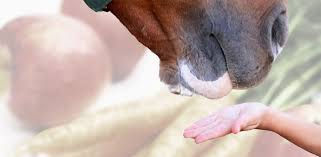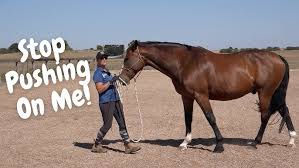How to Give Your Horse Treats Without Creating a "Treat Monster"
- Loz
- Aug 1
- 5 min read
Updated: Aug 18

Building Respectful Boundaries with Positive Reinforcement
Giving your horse a treat can be a rewarding way to bond and reinforce positive behaviours, but it’s all too easy for a kind gesture to quickly spiral into an annoying or even dangerous habit, if not managed properly. If you’ve ever had your horse nudging, mugging, or even nipping at your pockets in anticipation of a treat, you know exactly what a “treat monster” looks like. The good news is, with the right approach, you can offer rewards without sacrificing your personal space or your horse’s manners.
Why Boundaries Matter: The Dangers of the “Treat Monster”
Horses are big, powerful animals, and their size can pose significant risks when their behaviour becomes demanding or pushy. When they learn that pushy, mouthy, or demanding behaviour results in a treat, they can quickly escalate from innocent nudging to more aggressive outright bullying behaviours. Not only can this be frustrating, but it’s also unsafe—especially around children or less experienced handlers, or other horses. Allowing your horse to demand treats can erode the respect that is essential in a horse-human relationship, leading to increased anxiety for both the horse and the handler. Furthermore, it creates a horse that is increasingly difficult to manage on the ground, which can lead to dangerous situations.
By establishing clear boundaries, you can maintain a horse that is beautifully natured and safe to handle. It’s important to remember that horses are not lap dogs; their size and strength mean they can inflict serious harm if their behaviour escalates unchecked. A horse that feels entitled to treats can become a liability, making it essential to implement boundaries that ensure both your safety and the horse's well-being.
Testing/Signs of a “Treat Monster”
Your horse follows you around, constantly searching for food or treats, demonstrating a fixation that can be overwhelming.
They nudge, paw, or mouth your hands, pockets, or grooming kit, showing a lack of respect for personal space.
They exhibit agitation or pushy behaviour when they see or hear treat bags, indicating a learned expectation of rewards.
They lose focus on work, always checking to see if you have something for them, which can disrupt training sessions and activities.
They nip or show their teeth when no treat is forthcoming, a clear sign of impatience and entitlement.
They abruptly stop (without you applying any aids/cues) mid-ride for a snack on grass, demonstrating a lack of respect for your direction and safety.
Every time they see you (or someone else approaching), they nicker regardless of whether or not you have food, indicating an expectation rather than a greeting.
Some horse breeds are more food oriented; however, this does not justify allowing them to walk all over you in their quest for food.
While some horses may softly nicker when they see you, they shouldn’t expect food every time you come and go from their view throughout the day (and continue to respond with nickering).
If you are standing with your horse in a halter/lead rope, chatting with friends who have other horses, and your horse invades your space or that of others in search of treats, it signifies a lack of boundaries, and your total neglect of someone else's safety.
If you recognise any of these signs, your horse may already be on the path to becoming a "treat monster". The good news: you can retrain this behaviour with a simple, consistent approach that reinforces the boundaries you should establish.

The Calm and Respectful Treat Method
Follow these steps to give your horse a treat without encouraging demanding behaviour:
Prepare the Treat: Begin by placing a single treat in the palm of you hand. Softly close your hand into a fist, ensuring that the treat is hidden from view. This sets the stage for a controlled interaction.
Present Your Hand: Turn your closed hand so the pinky finger side is facing your horse’s head, positioning it just beside their mouth. This allows the horse to sense the treat without immediately accessing it.
Patiently Wait: Your horse may start mouthing at your fist in an attempt to get the treat. Gently use the fisted hand to bump the horse lightly (where you were positioned from step 2 above). This may take some time, so patience is essential during this phase.
It is crucial to emphasize we do not hit, slap, poke or whack horses! Be firm, but gentle with this action, as horses have a high concentration of nerves on their face, and they will feel a soft bump.
Reward: Once your horse stops mouthing or asking for the treat and moves their head slightly away, turn your fist over and open your hand to reveal your palm, offering the treat to the horse. This reinforces the desired behaviour of waiting for permission.
Be Consistent: Use this approach every time you wish to offer a food treat or reward to your horse. Consistency is key in establishing a new, safer boundary and habit that your horse will learn to respect.
Handling the Situation When Other Horses/Humans Are Around
When your horse begins to view other humans as potential sources of treats, it can complicate matters. So what do you do when your horse also sees other humans as other treat gods or goddesses'?
Consider carrying a whip/flag or using a lead rope that has a popper on the end. These tools can help you maintain control and assert boundaries effectively.
Immediately guide the horse to back up and away from the person (a minimum of 2m). Ensure they stand there patiently and do not creep or move back towards you. Interesting observation here: you may find these horses exhibit leading issues (who would've thought it)!
You may need to adopt a more assertive approach initially; do not be overly soft or hesitant, as this invasion of space can be unsafe for you and for other people or horses in the vicinity.
This behaviour mimics what horse do in a herd to establish boundaries - observe a herd during feeding, and you will notice how a less dominant horse approaches a more dominant horse for food. (Try Dr Google for this one!)
Continuously reaffirming that the horse needs to maintain this 2m boundary. You may need to repeat the above steps to reset this boundary effectively. Allowing the boundary to shrink does not reinforce the new behaviour; thus consistency is crucial to forming a good new habit.
Always consider the question, "Would I be okay if someone else's horse did this to me?" This perspective should enhance your safety awareness. If the answer is no, then it's time to reestablish boundaries with your horse.
Final Thoughts
Establishing respectful boundaries with your horse is essential for both your safety and the well-being of your equine companion. By implementing the calm and respectful treat method, you can foster a positive relationship that encourages good manners and reduces the risk of developing a "treat monster." Remember, consistency is key—both in your interactions with your horse and in how you manage their expectations around treats.
Now that you have some strategies to help you navigate treat-giving effectively, we’d love to hear from you! Have you ever dealt with a “treat monster” in your barn? What methods have you found effective in establishing boundaries with your horse? Share your experiences and thoughts in the comment section below! Your insights could help others in the community as they work to create a safe and respectful environment for their horses.


Comments